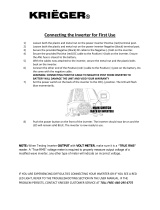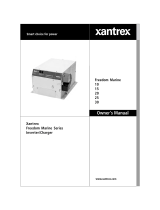
! Ensure your battery size is big enough and Voltage is correct.
A. CORRECTLY CONNECTING THE INVERTER FOR FIRST USE.
1) Secure the provided Negative(black) DC cable connect to the Negative(-)bolt on the inverter, and the other
end to the Negative (-)post on the battery.
2) Secure the provided Positive(Red) DC cable to the Positive(+)bolt on the inverter, and the other end to the
Positive (+)post on the battery.
3) The nuts of the connection posts must be tightened to ensure well connected.
4) Press the power switch for one second, because it is a long press type switch.
WARNING: REVERSE CONNECTED THE CABLES WILL DAMAGE THE INVERTER AND AVOID YOUR WARRANTY!
QUICK KNOWLEDGE ABOUT INVERTER
Call support: +1 3233 665600
B. TROUBLESHOOTING TIPS
Problem Reason
Solutions
Low input DC voltage Low input DC voltage
High input DC voltage
Do not use it when the battery is charging.
Check the rated voltage of the battery and
make sure that it is in the allowable range of
the input voltage.
Overload
Reduce the load power
Over temperature
Cut off the load and let it cool naturally for
10 to 30 minutes.
Restart it after it resumes to normal
temperature. Reduce the load.
Avoid blocking the vent and improve the
ventilation condition.
No output voltage
and buzzer
sounds
continuously?
A True RMS voltage meter is
required to properly measure output
voltage of modified wave inverter
1. The power switch is off.
2. Poor contact with battery.
Press the power switch for 1-2 second to
turn it on, it is a long press type switch
Check the cables and make sure they are
tightly connected.
No AC output
voltage?
Output voltage
below 100V AC?
Cannot drive the
load?
Tester indicated
"Open Ground"”
Starting alarm ?
Got 40V or so while
testing inverter's
ground wire and
zero line ?
The main reason is that the
instantaneous current is too large, which
leads to the detection of low voltage and
triggles under-voltage alarm.
This voltage has no meaning, zero
line can be ground.
Test output voltage with a True RMS meter
Try to maintain the input voltage in the
range of rated power
Change the battery of the meter then test
again.
Please restart the inverter several times.
This is normal, there is no current leakage.
This is because it is not connected to a
"true Earth ground", meaning it is not
connected to a metal rod stuck in the
Earth. It would be impossible to do so in a
boat or car while moving. The power
inverter DOES NOT and cannot create a
true Earth ground on its own.
Reduce the load power, or turn on the
appliance first, then turn on the inverter.
Choose a bigger inverter
Change a bigger battery and ensure fully
charged
Don't need the tester to do the Grounding
Test.
Refer to the manual to do the Grounding
1.
2.
Load power is too large, or the actual
power of the appliance exceeds
nominal power.
The starting power is larger than rated
power (especially for appliances with
motor).
3. Battery is too small






